 |
 |
|||||||||||||
|
|||||||||||||
|
|||||||||||||
|
On Wednesday, 24 September, KEK held a symposium entitled “Starting up the world's most powerful accelerators: LHC and J-PARC” in Tokyo. This symposium was the second one in a series of symposiums aiming for gaining more understanding of accelerator science. The main audience of this symposium was the industry. “We would like to place an emphasis on the collaboration between industry, the universities and the laboratories which enable those big accelerator projects,” said Mitsuaki Nozaki, the chief organiser of the symposium. “I believe that efforts like these are essential to realise another big accelerator project in the future, such as the ILC,” he added. The main theme of the symposium was the technology used in LHC and JPARC. “It is unusual to have speakers from industry in particle physics symposiums,” said Junpei Fujimoto, the programme organiser of the symposium. The sessions focused more on the unprecedented technologies used at both accelerators than physics this time. The symposium included lectures by researchers from industry and the scientists, reporting on results achieved through industry-university-laboratory collaborations. “We would like to 'promote' the accelerator science from both the physical and the technical point of view,” said Fujimoto. The first half of the symposium consisted of a series of sessions on LHC. Tomio Kobayashi, professor at University of Tokyo, started with the lecture entitled "Expected physics performance from LHC", followed by Akira Yamamoto, ILC project manager who designed the superconducting magnets for the ATLAS detector at the LHC, explaining "Japanese companies' superb technology which supported the LHC" illustrated by examples. Then two industry representatives gave lectures on these technologies. Shinichiro Meguro from Furukawa Electric talked about superconducting cables, and Seiichiro Yoshinaga from IHI Corporation talked about refrigerator systems, of which they have the world's largest capacity. Both Furukawa and IHI have been awarded the LHC Golden Hadron Award in 2003 for their outstanding achievements and contributions. The second half of the symposium started with a session by Susumu Ikeda of KEK entitled "Neutron science expected at J-PARC." The J-PARC session also invited two speakers from the industry: Kenichi Hayashi from Toshiba Electron Tubes & Devices Co., Ltd, talking about RF technology, and Katsuya Hirota from Japan Neutron Optics. Even though the sessions were a bit technical in content, the symposium was well received to attract approximately 200 attendees, including four journalists and some the science fans who read the symposium ad in newspapers. The next symposium will be held in March 2009, with the theme of accelerators used in medicine. “The target audience for the next symposium will be broader,” said Nozaki. “Medical applications would be a very interesting theme for people who are health-conscious”. With these symposia, the Japanese accelerator science community is seeking a way to get more awareness in society. -- Rika Takahashi |
|||||||||||||
| © International Linear Collider |

